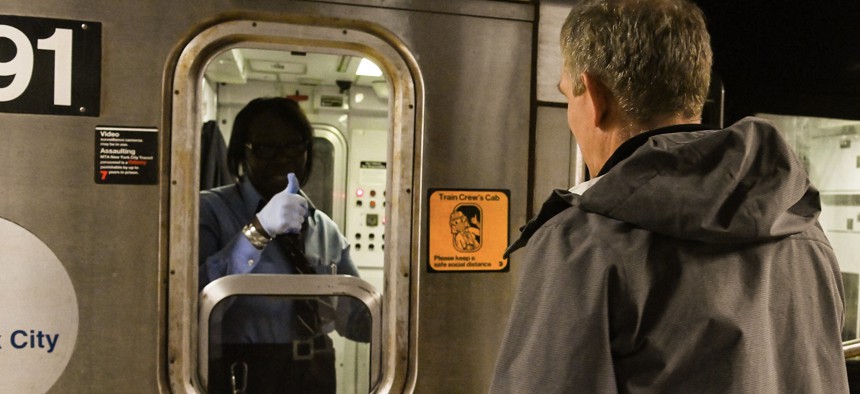Opinion
Opinion: Labor and the MTA must work together to improve the nation's largest transit system
With the TWU 100’s contract expired, there’s an opportunity for both sides to work together to improve service for New Yorkers

Metropolitan Transportation Authority Chair & CEO Janno Lieber gets a thumbs up from a New York City subway conductor during a visit to the 14 Street-Union Square Station on April 28, 2023. Marc A. Hermann / MTA
Few organizations suffered as much during the coronavirus pandemic as the Metropolitan Transportation Authority. The system was threatened by lost ridership and revenues, perceived and real safety fears, and declining productivity. As the MTA struggles to stabilize and adapt, its management and workforce both need to be flexible and creative so they can cope with the changing ridership demands of a post-pandemic world.
The federal government covered the MTA’s financial shortfall during the pandemic, but that funding will soon run out. To narrow the MTA’s future budget gaps, Gov. Kathy Hochul and the Legislature approved a stabilization plan that raised the Payroll Mobility Tax on New York City businesses by $1.1 billion, increased city support of paratransit $165 million, and dedicated future revenues from casinos. The MTA will modestly increase drivers’ tolls and riders’ fares and save $400 million by increasing its own productivity, and taxpayers will provide a one-time $300 million infusion. With the federal government finally green-lighting congestion pricing, drivers will pay $1 billion to support $15 billion in infrastructure investments.
Despite the substantial new resources, the regional transportation system that undergirds our economy and quality of life is still at risk. It cannot flexibly adapt and its operating costs, components of which are far higher than other large systems in the U.S., must be contained. That is only possible through adapting work rules and benefits that have been written into its collective bargaining contracts over many years.
New York City’s employers, riders, drivers, and taxpayers have all been asked to all step up support. Labor should also contribute to the MTA’s stability and flexibility.
On Monday, the contract between MTA and TWU 100, the MTA’s largest labor union, expired. MTA workers were on the frontlines during COVID-19 and the city could not have carried on without them. As the MTA and TWU negotiate a new contract, the challenge is to support essential workers who kept the city moving during the pandemic while securing savings and efficiencies necessary to provide critical services and stabilize the MTA’s operating budget. Making changes to outdated work rules and how the MTA handles health care would save riders and taxpayers hundreds of millions of dollars a year.
The MTA and TWU should focus on several areas of improvement.
Transit workers need to return to pre-COVID attendance levels. According to the MTA, over the last two decades, the average number of days worked annually by subway and bus workers shrunk by 19 – nearly an entire month’s work. Plummeting employee availability hurts riders; nearly 50 million subway and bus customer trips in 2022 were canceled because of crew shortages, stranding New Yorkers who rely on transit. The silver lining is that a small fraction of the workforce drives this trend. Contract changes to fix this would affect few workers while improving service and cutting overtime costs.
The MTA’s operations must innovate. Improvements in signals, new subway cars, and investments in safety mean it is time for the MTA to expand One Person Train Operation (OPTO), which other systems embraced decades ago. A handful of subway lines already successfully operate with OPTO. Continuing to pay multiple operators to manually run trains when the MTA – and taxpayers – have invested significant capital dollars to run trains automatically makes no sense.
The MTA and labor need to modernize how transit workers pick the time and location of their shifts. Currently, subway and bus shifts are chosen through an in-person, on-paper process more suited to 1923 than 2023. This broken system hurts both workers and riders. A modern, online system would enable the MTA to modify service more quickly and allow workers to pick their schedules more efficiently and flexibly.
Ballooning health care costs should be restrained. The MTA and TWU should follow the lead of New York City and its recent contract negotiations by switching retirees to a high quality Medicare Advantage plan. Doing this would save the MTA millions without reducing benefits.
More broadly, the MTA and its labor partners must be more creative. This winter, the MTA and TWU agreed to bring agents out of obsolete token booths and directly serve customers in stations, providing a roadmap for collaboration to benefit riders and transit workers alike. More creative and flexible work assignments and scheduling will improve service and allow the MTA to adapt to riders’ needs.
These efficiencies and savings would help the MTA afford reasonable salary increases that the hard-working men and women of the TWU deserve. If all the stakeholders can come to the table, the MTA can deliver the transit service our city and region require in a changing world, while securing its financial future and supporting its workers.
Andrew Rein is president of the Citizens Budget Commission, Tom Wright is president and CEO of the Regional Plan Association and Kathryn Wylde is president and CEO of the Partnership for NYC.
NEXT STORY: Commentary: Shedding light on NYC jail commissioner’s inaction shows what a different story he’s telling

